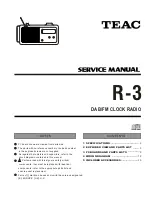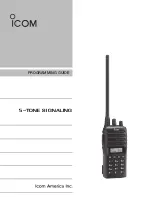
10
F. Command Board
The command board is in the top side of the radio
housing. The board contains the radio’s microcomputer
with its memory and support circuits, voltage regulators,
audio, signalling, and power control circuits. Connected
to the command board are the memory board,
HearClear board, control head, RF board, RF PA/acces-
sories, and the RX front-end connector.
The microcomputer (U520) controls audio levels,
signalling, receive/transmit frequencies, power levels,
control head display, and other radio functions, using
either direct logic control, or synchronous and asyn-
chronous serial communications paths to the devices.
The microcomputer executes a stored program located
in PROM on the memory board. Data is transferred to
and from the memory board via the microcomputer data
bus. The memory location from which data is read, or to
which data is written, is selected via the address lines.
The upper eight address lines are applied directly from
the microcomputer to the memory board, while the lower
address lines are latched by the support logic IC (U521)
and then applied to the memory board.
The support logic IC (U521) acts as an extension of
the microcomputer by providing logic functions such as
lower address latch, reset, memory address decoding,
and additional control lines for the radio.
The serial input/output IC (U522) provides com-
mand board functions including buffers for PTT, channel
activity, squelch mute, busy, and data transmission, and
logic functions for switched B+, emergency, reset, and
power control.
The regulator and power control circuits include an
unsw5V (UNSW5V) discrete circuit, measured
at Q521 emitter, and the regulator/power control IC
(U500), which produces both sw5V (SW5V),
measured at U500-14, and 9.6V, measured at Q500 col-
lector. The UNSW5V source is used by U500 as a
reference for its sw5V source. UNSW5VFIL (fil-
tered UNSW5V), measured at U520-26, is used for the
microcomputer circuits. SW5V and 9.6V, from U500, are
controlled via a digital transistor from U522 (serial
input/output IC). In the power control circuitry, U500
receives power set and limit inputs from the digital-to-
analog IC, and feedback from the RF power amplifier.
Based on those inputs, U500 produces a control voltage
for the desired RF power level to the antenna.
The reset circuits consist of the power-on reset
(U521-1), high/low battery voltage reset, and the exter-
nal bus system reset (U522 and U521 circuits). The
high/low battery voltage can be located one of two
places. If U521 has part number 51-83977M87, the cir-
cuit is in U521. If U521 has part number 51-83977M72,
the circuit is on the HearClear board. The reset circuits
allow the microcomputer to recover from an unstable sit-
uation; that is, no battery on the radio, battery voltage
too high or too low, and remote devices on the external
bus not communicating.
The microcomputer controls the crystal pull circuit,
via U521 and U520, to adjust the crystal oscillator’s fre-
quency on the microcomputer so that the E-clock
frequency’s harmonics do not cause interference with
the radio’s receive channel.
The signalling filter IC (U700) performs signalling
encode and decode functions. Receive signalling from
the detector is limited in this IC, then routed to the
microcomputer for actual decoding. For transmit sig-
nalling, clock signals from the microcomputer are filtered
and routed to the audio filter IC (U400) to be combined
with transmit audio. U700 requires a 2.1 MHz clock sig-
nal to be functional, and is programmed using clock,
data, and U700 select lines from the microcomputer.
Audio filtering, routing, and volume are controlled by
the audio filter IC (U400). This IC performs PL/DPL
encode and decode filtering as well as alert tone gener-
ation. It contains attenuators for volume, squelch,
deviation, and compensation. TX and RX audio options
connect through this IC. It requires a 2.1 MHz clock to
be functional and is programmed using clock, data, and
U400 select lines from the microcomputer.
V. POWER AMPLIFIERS
This information applies to all 4-watt, 12-watt, and
30-watt models. The primary difference among the
three transmitters is the addition of a final stage on the
30-watt. Also, the 4-watt and 30-watt transmitters have
larger heatsinks and circuit boards. This theory should
help isolate problems to the board level with circuit
board replacement as the intended repair procedure.
A. Gain Stages
The first gain stage is a low-level transmit buffer
which boosts power, typically, from 90 milliwatts to 320
milliwatts. This stage drives the power module which
increases power to 15 watts. The power module is the
last gain stage in the 4-watt and 12-watt radios; howev-
er, in the 30-watt radio, an additional final stage boosts
power, typically, to 43 watts. Following the last gain
stage of either model, PIN diodes switch the signal flow
either from the antenna to the receiver, or from the last
gain stage to the antenna. Either way, the signal pass-
es through a low-pass filter.
B. Power Control
Power is controlled with a directional coupler and
detector network that senses the forward power from
the last gain stage. The detected voltage is fed back to
the command board control circuitry where it is com-
Summary of Contents for Spectra
Page 6: ...v PERFORMANCE SPECIFICATIONS FOR SPECTRA PRIVACY PLUS TRUNKED CONVENTIONAL 900 MHz RADIO ...
Page 7: ...vi PERFORMANCE SPECIFICATIONS FOR SPECTRA SMARTNET TRUNKED CONVENTIONAL 900 MHz RADIO ...
Page 8: ...vii PERFORMANCE SPECIFICATIONS FOR SPECTRA 9000 RADIOS 900 MHz 30 WATTS ...
Page 25: ...1 GENERAL INFORMATION 1 ...
Page 73: ...53 INSERT GPW 7221 B Figure 22 Front Panel Diagnostics Key Closure Displays ...
Page 75: ...INSERT GXW 4278 O PICKUP FROM PW 4320 O 55 CONTROL STATION WIRING DIAGRAM ...
Page 79: ...PUSHBUTTON SPECTRA 900 MHz RADIO MECHANICAL EXPLODED VIEW 59 INSERT GXW 6225 B ...
Page 96: ...82 MECHANICAL EXPLODED VIEW PARTS LIST FOR SPECTRA 900 MHz RADIO ...
















































